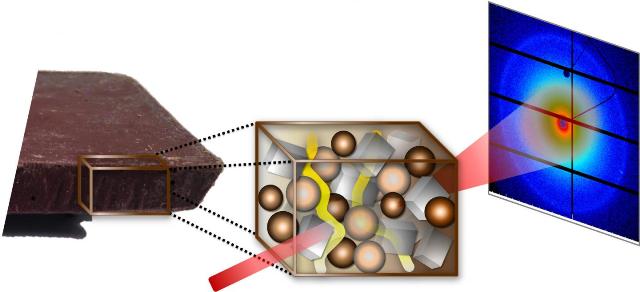May 8 2015
Researchers from the Deutsches Elektronen-Synchrotron (DESY), the Hamburg University of Technology (TUHH), and Nestlé have conducted a joint X-ray study to find out the dynamic mechanisms that lead to formation of undesired whitish fat bloom on chocolate.
 With DESY's bright X-ray source PETRA III the scientists could follow the migration of liquid fat (yellow) through chocolate live for the first time. The characteristic X-ray pattern (right) reveal details down to nanometre sizes. Credit: Svenja Reinke/Hamburg University of Technology
With DESY's bright X-ray source PETRA III the scientists could follow the migration of liquid fat (yellow) through chocolate live for the first time. The characteristic X-ray pattern (right) reveal details down to nanometre sizes. Credit: Svenja Reinke/Hamburg University of Technology
The findings of this study may help enhance the quality of chocolate. "Although fat blooming is perfectly harmless, it causes millions in damage to the food industry as a result of rejects and customer complaints," explains the main author of the study, Svenja Reinke, from the Hamburg University of Technology (TUHH). "Despite this well known quality issue, comparatively little has been known until now about its root causes."
A whitish fat bloom is formed when ingredients of chocolate, such as cocoa butter and other such liquid fats, migrate to the chocolate’s surface and crystallize. "This can happen when liquid chocolate cools down in an uncontrolled manner and unstable crystals form, for example. But even at room temperature, a quarter of the lipids contained in chocolate are already in a liquid state", Reinke explains. Nougat and other such ingredients or liquid fillings could hasten the white fat bloom formation.
Storing chocolate at a high storage temperature and for a long period increases the possibilities of fat bloom formation. This has led to the popular belief that signs of white coloration denote signs of chocolate that has got spoilt or that it has become old.
"Even though fat bloom does not actually constitute any deterioration in the quality of the product, the visual alteration associated with it can lead to a large number of consumer complaints," points out Prof. Dr.-Ing. Stefan Palzer, from the food company Nestlé. "This is why fat bloom continues to be one of the most important quality defects in the confectionary industry."
The PETRA III x-ray source at DESY has helped study the processes that lead to the formation of whitish fat blooms in real time. The main ingredients of chocolate are cocoa, cocoa butter, milk powder and sugar. Various mixes of these components were finely ground and then analyzed using PETRA III. The fine grinding was intended to quicken the processes.
"The technology used to examine the samples shows us both the fat crystals and the pores inside the product, down to a scale of a few nanometres," explains Prof. Dr.-Ing. Stefan Heinrich from TUHH, leader of the investigation.
The team then studied the fat migration that takes place in chocolates. Drops of sunflower oil were placed on the samples and the reaction was observed. "First of all, wetting takes place within seconds. The oil penetrates very quickly into even the smallest pores, probably through capillary action," Reinke describes their observations.
Secondly, the liquid fat alters the internal structure of the chocolate. "Over a period of hours, the liquid fat dissolves additional crystalline lipid structures, which makes the entire structure of the chocolate softer. This in turn increases the migration of lipids."
Until now, the dynamics involved in the fat bloom development have remained unknown. Earlier studies had suggested that the crystalline structure could be playing an important role in the formation of fat bloom.
"For the first time, we have been able to track in detail the dynamic mechanisms that lead to the creation of fat bloom," explains DESY scientist Dr. Stephan Roth, head of the P03 beamline at PETRA III, at which the experiments were conducted.
"The method used is known as small-angle X-ray scattering and is precisely adapted to real-time investigations of this kind, and to observing the structural changes caused by the moving lipids. The joint study has supplied important information as to how we can study structural changes in such 'everyday' multi-component systems."
Based on the findings of this study, the chocolate industry has been able to develop methods to reduce whitish fat bloom. "One consequence might, for example, be to reduce the porosity of the chocolate during manufacture, so that the fat migrates more slowly," explains Reinke.
"Another approach is to limit the amount of fat that is present in a liquid form by storing the product in cool, but not too cold, conditions. 18 degrees Celsius is ideal." Chocolate is very sensitive to fluctuations in temperature. "Just a few degrees make a big difference," Reinke notes.
"At 5 degrees, basically, all cocoa butter is solid; and above about 36 degrees everything is liquid." On top of this, the type of crystals in the chocolate plays an important role. "Cocoa butter crystallises in six different crystal forms," explains Reinke. "The amount of fluid also depends on the form of the crystals." Controlling the crystallization that takes place could also help limit creation of the fat bloom.
"The experiments that have been conducted allow us as manufacturers of quality chocolate to draw conclusions concerning the root causes of lipid migration leading to blooming," points out Palzer. "These findings, which we obtained in collaboration with the Hamburg University of Technology and the team at DESY using the latest analytical technologies, provide a solid foundation for developing suitable methods for avoiding one of the most important quality defects in the food industry."
The researchers have published the study results in the Applied Materials and Interfaces journal.